Report on Advanced BPMN and Business Process Management Lifecycle
VerifiedAdded on 2023/03/23
|12
|1326
|83
Report
AI Summary
This report provides a detailed analysis of Business Process Management (BPM) and its lifecycle, incorporating Advanced BPMN concepts. It addresses key aspects such as value-added and non-value-added activities within business processes, lead time analysis, and constraint identification. The report suggests improvements like online feedback systems and automated request allocation to enhance organizational efficiency. It also includes a risk assessment of potential issues, using tools like the Fishbone diagram to identify root causes and proposing a to-be model for process optimization. The document also includes a comparison of Business Process Reengineering (BPR) and BPM, exploring their benefits, shortcomings, and potential integration strategies for continuous improvement.

Running head: BUSINESS PROCESS MANAGEMENT
Business Process Management
Name of the Student:
Name of the University:
Author Note
Business Process Management
Name of the Student:
Name of the University:
Author Note
Paraphrase This Document
Need a fresh take? Get an instant paraphrase of this document with our AI Paraphraser
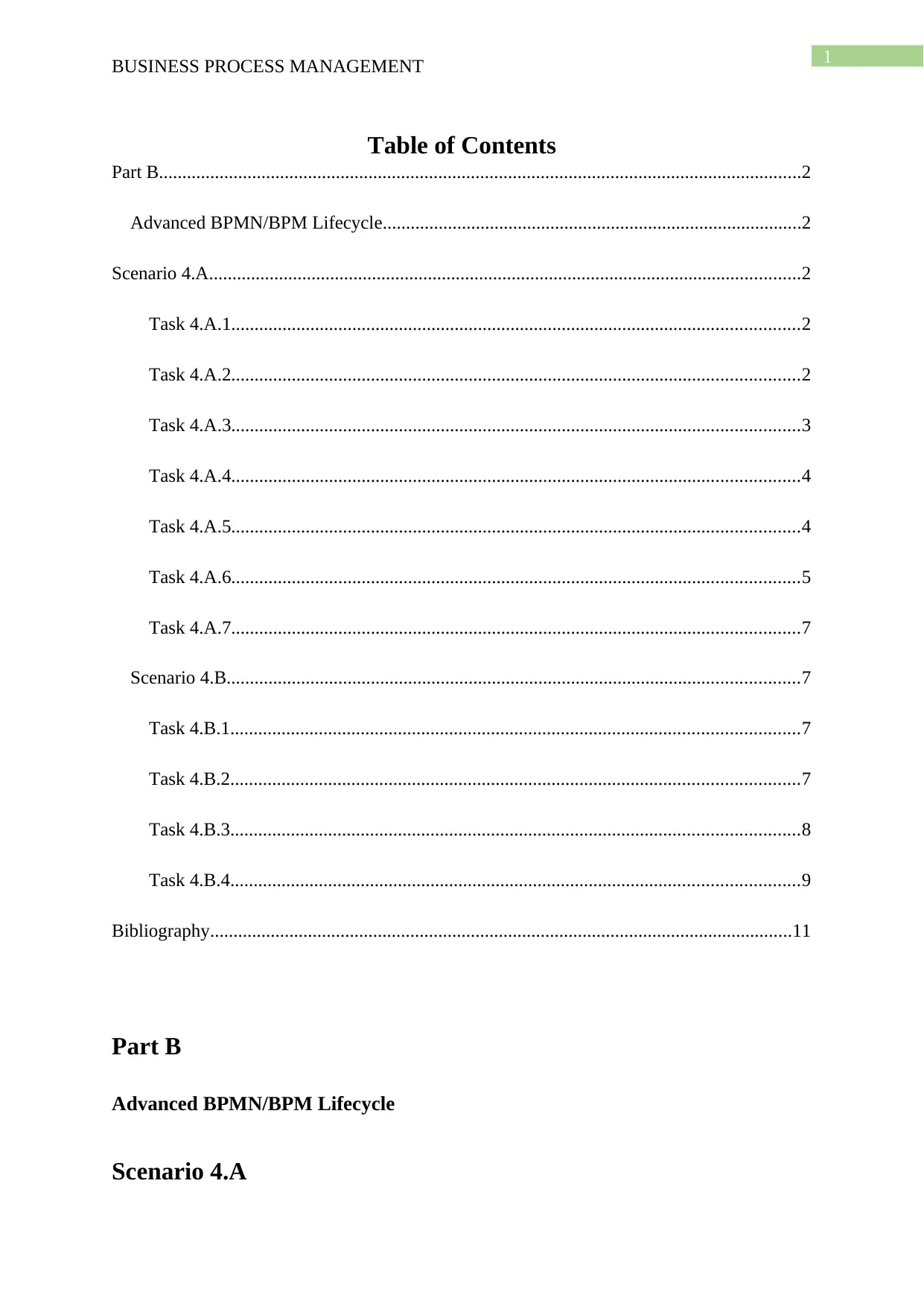
1
BUSINESS PROCESS MANAGEMENT
Table of Contents
Part B..........................................................................................................................................2
Advanced BPMN/BPM Lifecycle..........................................................................................2
Scenario 4.A...............................................................................................................................2
Task 4.A.1..........................................................................................................................2
Task 4.A.2..........................................................................................................................2
Task 4.A.3..........................................................................................................................3
Task 4.A.4..........................................................................................................................4
Task 4.A.5..........................................................................................................................4
Task 4.A.6..........................................................................................................................5
Task 4.A.7..........................................................................................................................7
Scenario 4.B...........................................................................................................................7
Task 4.B.1..........................................................................................................................7
Task 4.B.2..........................................................................................................................7
Task 4.B.3..........................................................................................................................8
Task 4.B.4..........................................................................................................................9
Bibliography.............................................................................................................................11
Part B
Advanced BPMN/BPM Lifecycle
Scenario 4.A
BUSINESS PROCESS MANAGEMENT
Table of Contents
Part B..........................................................................................................................................2
Advanced BPMN/BPM Lifecycle..........................................................................................2
Scenario 4.A...............................................................................................................................2
Task 4.A.1..........................................................................................................................2
Task 4.A.2..........................................................................................................................2
Task 4.A.3..........................................................................................................................3
Task 4.A.4..........................................................................................................................4
Task 4.A.5..........................................................................................................................4
Task 4.A.6..........................................................................................................................5
Task 4.A.7..........................................................................................................................7
Scenario 4.B...........................................................................................................................7
Task 4.B.1..........................................................................................................................7
Task 4.B.2..........................................................................................................................7
Task 4.B.3..........................................................................................................................8
Task 4.B.4..........................................................................................................................9
Bibliography.............................................................................................................................11
Part B
Advanced BPMN/BPM Lifecycle
Scenario 4.A
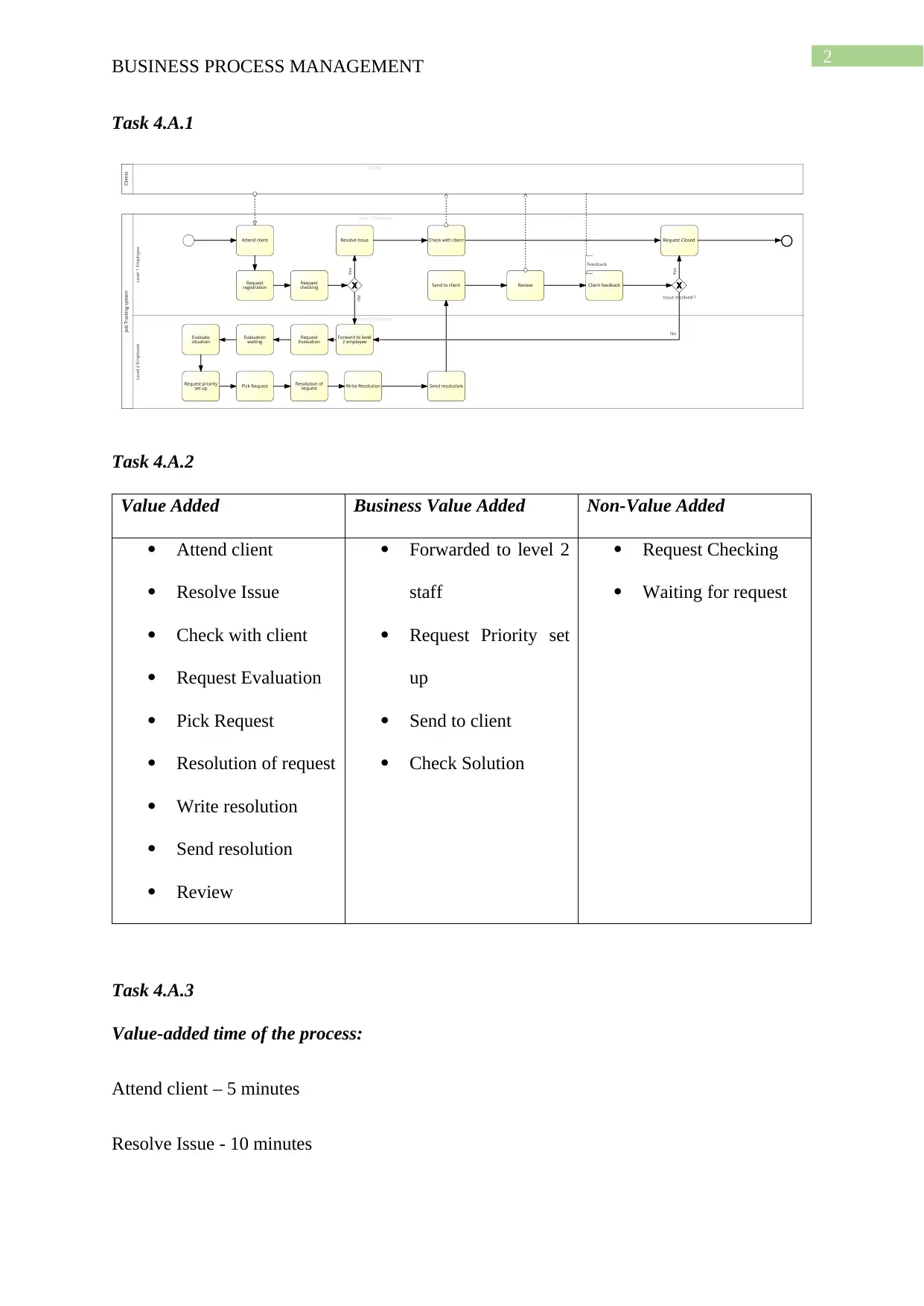
2
BUSINESS PROCESS MANAGEMENT
Task 4.A.1
Task 4.A.2
Value Added Business Value Added Non-Value Added
Attend client
Resolve Issue
Check with client
Request Evaluation
Pick Request
Resolution of request
Write resolution
Send resolution
Review
Forwarded to level 2
staff
Request Priority set
up
Send to client
Check Solution
Request Checking
Waiting for request
Task 4.A.3
Value-added time of the process:
Attend client – 5 minutes
Resolve Issue - 10 minutes
BUSINESS PROCESS MANAGEMENT
Task 4.A.1
Task 4.A.2
Value Added Business Value Added Non-Value Added
Attend client
Resolve Issue
Check with client
Request Evaluation
Pick Request
Resolution of request
Write resolution
Send resolution
Review
Forwarded to level 2
staff
Request Priority set
up
Send to client
Check Solution
Request Checking
Waiting for request
Task 4.A.3
Value-added time of the process:
Attend client – 5 minutes
Resolve Issue - 10 minutes
⊘ This is a preview!⊘
Do you want full access?
Subscribe today to unlock all pages.

Trusted by 1+ million students worldwide
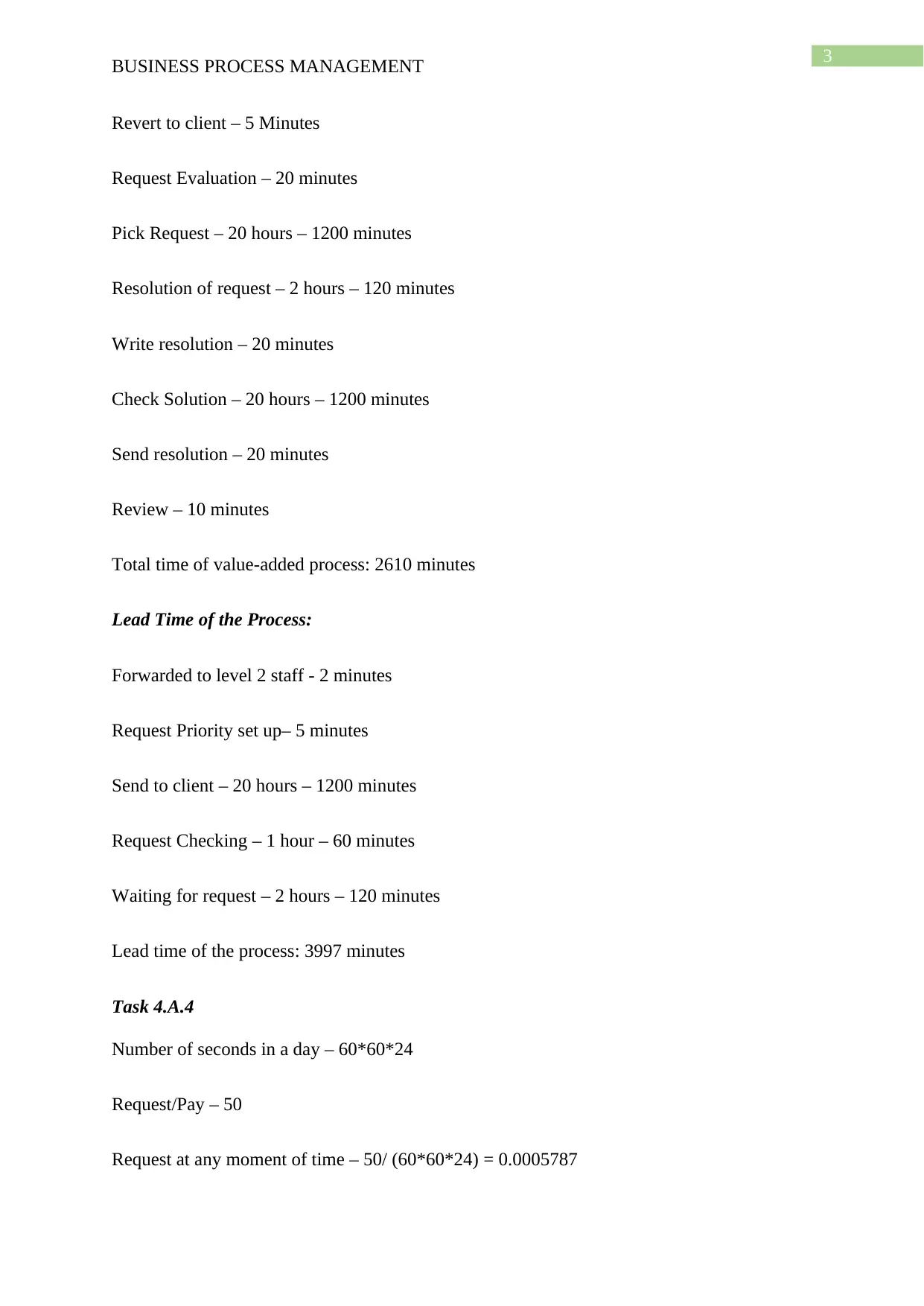
3
BUSINESS PROCESS MANAGEMENT
Revert to client – 5 Minutes
Request Evaluation – 20 minutes
Pick Request – 20 hours – 1200 minutes
Resolution of request – 2 hours – 120 minutes
Write resolution – 20 minutes
Check Solution – 20 hours – 1200 minutes
Send resolution – 20 minutes
Review – 10 minutes
Total time of value-added process: 2610 minutes
Lead Time of the Process:
Forwarded to level 2 staff - 2 minutes
Request Priority set up– 5 minutes
Send to client – 20 hours – 1200 minutes
Request Checking – 1 hour – 60 minutes
Waiting for request – 2 hours – 120 minutes
Lead time of the process: 3997 minutes
Task 4.A.4
Number of seconds in a day – 60*60*24
Request/Pay – 50
Request at any moment of time – 50/ (60*60*24) = 0.0005787
BUSINESS PROCESS MANAGEMENT
Revert to client – 5 Minutes
Request Evaluation – 20 minutes
Pick Request – 20 hours – 1200 minutes
Resolution of request – 2 hours – 120 minutes
Write resolution – 20 minutes
Check Solution – 20 hours – 1200 minutes
Send resolution – 20 minutes
Review – 10 minutes
Total time of value-added process: 2610 minutes
Lead Time of the Process:
Forwarded to level 2 staff - 2 minutes
Request Priority set up– 5 minutes
Send to client – 20 hours – 1200 minutes
Request Checking – 1 hour – 60 minutes
Waiting for request – 2 hours – 120 minutes
Lead time of the process: 3997 minutes
Task 4.A.4
Number of seconds in a day – 60*60*24
Request/Pay – 50
Request at any moment of time – 50/ (60*60*24) = 0.0005787
Paraphrase This Document
Need a fresh take? Get an instant paraphrase of this document with our AI Paraphraser
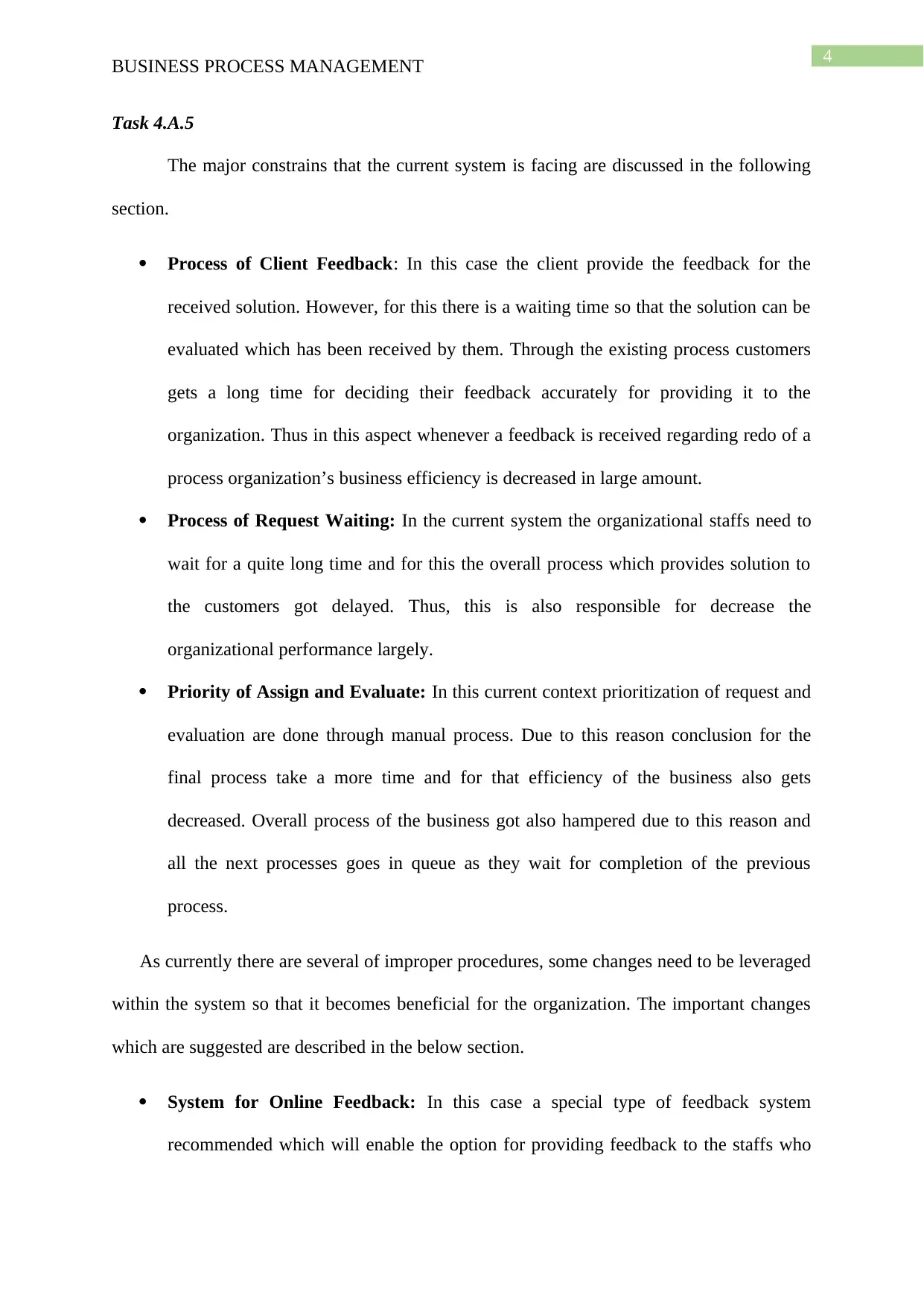
4
BUSINESS PROCESS MANAGEMENT
Task 4.A.5
The major constrains that the current system is facing are discussed in the following
section.
Process of Client Feedback: In this case the client provide the feedback for the
received solution. However, for this there is a waiting time so that the solution can be
evaluated which has been received by them. Through the existing process customers
gets a long time for deciding their feedback accurately for providing it to the
organization. Thus in this aspect whenever a feedback is received regarding redo of a
process organization’s business efficiency is decreased in large amount.
Process of Request Waiting: In the current system the organizational staffs need to
wait for a quite long time and for this the overall process which provides solution to
the customers got delayed. Thus, this is also responsible for decrease the
organizational performance largely.
Priority of Assign and Evaluate: In this current context prioritization of request and
evaluation are done through manual process. Due to this reason conclusion for the
final process take a more time and for that efficiency of the business also gets
decreased. Overall process of the business got also hampered due to this reason and
all the next processes goes in queue as they wait for completion of the previous
process.
As currently there are several of improper procedures, some changes need to be leveraged
within the system so that it becomes beneficial for the organization. The important changes
which are suggested are described in the below section.
System for Online Feedback: In this case a special type of feedback system
recommended which will enable the option for providing feedback to the staffs who
BUSINESS PROCESS MANAGEMENT
Task 4.A.5
The major constrains that the current system is facing are discussed in the following
section.
Process of Client Feedback: In this case the client provide the feedback for the
received solution. However, for this there is a waiting time so that the solution can be
evaluated which has been received by them. Through the existing process customers
gets a long time for deciding their feedback accurately for providing it to the
organization. Thus in this aspect whenever a feedback is received regarding redo of a
process organization’s business efficiency is decreased in large amount.
Process of Request Waiting: In the current system the organizational staffs need to
wait for a quite long time and for this the overall process which provides solution to
the customers got delayed. Thus, this is also responsible for decrease the
organizational performance largely.
Priority of Assign and Evaluate: In this current context prioritization of request and
evaluation are done through manual process. Due to this reason conclusion for the
final process take a more time and for that efficiency of the business also gets
decreased. Overall process of the business got also hampered due to this reason and
all the next processes goes in queue as they wait for completion of the previous
process.
As currently there are several of improper procedures, some changes need to be leveraged
within the system so that it becomes beneficial for the organization. The important changes
which are suggested are described in the below section.
System for Online Feedback: In this case a special type of feedback system
recommended which will enable the option for providing feedback to the staffs who
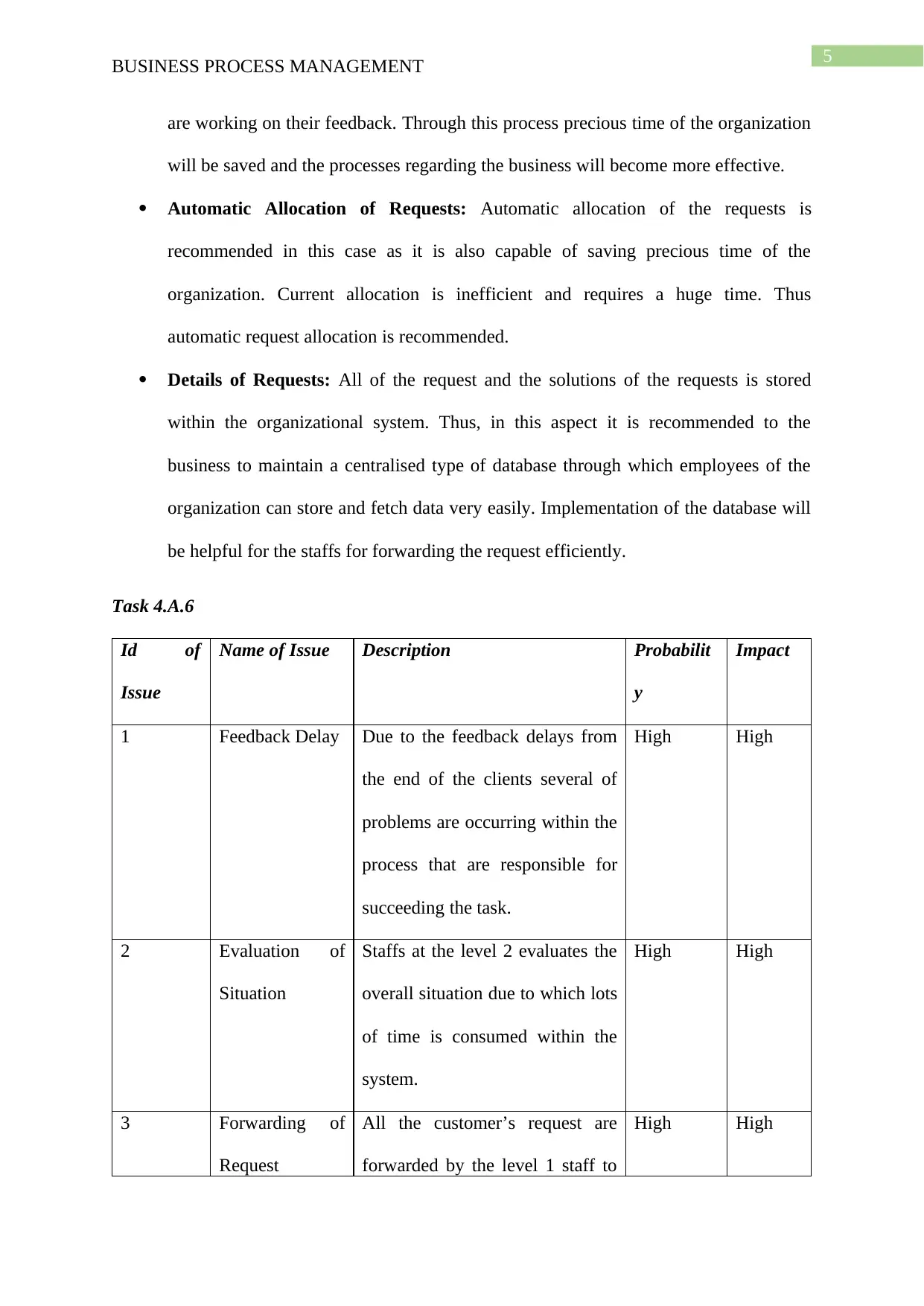
5
BUSINESS PROCESS MANAGEMENT
are working on their feedback. Through this process precious time of the organization
will be saved and the processes regarding the business will become more effective.
Automatic Allocation of Requests: Automatic allocation of the requests is
recommended in this case as it is also capable of saving precious time of the
organization. Current allocation is inefficient and requires a huge time. Thus
automatic request allocation is recommended.
Details of Requests: All of the request and the solutions of the requests is stored
within the organizational system. Thus, in this aspect it is recommended to the
business to maintain a centralised type of database through which employees of the
organization can store and fetch data very easily. Implementation of the database will
be helpful for the staffs for forwarding the request efficiently.
Task 4.A.6
Id of
Issue
Name of Issue Description Probabilit
y
Impact
1 Feedback Delay Due to the feedback delays from
the end of the clients several of
problems are occurring within the
process that are responsible for
succeeding the task.
High High
2 Evaluation of
Situation
Staffs at the level 2 evaluates the
overall situation due to which lots
of time is consumed within the
system.
High High
3 Forwarding of
Request
All the customer’s request are
forwarded by the level 1 staff to
High High
BUSINESS PROCESS MANAGEMENT
are working on their feedback. Through this process precious time of the organization
will be saved and the processes regarding the business will become more effective.
Automatic Allocation of Requests: Automatic allocation of the requests is
recommended in this case as it is also capable of saving precious time of the
organization. Current allocation is inefficient and requires a huge time. Thus
automatic request allocation is recommended.
Details of Requests: All of the request and the solutions of the requests is stored
within the organizational system. Thus, in this aspect it is recommended to the
business to maintain a centralised type of database through which employees of the
organization can store and fetch data very easily. Implementation of the database will
be helpful for the staffs for forwarding the request efficiently.
Task 4.A.6
Id of
Issue
Name of Issue Description Probabilit
y
Impact
1 Feedback Delay Due to the feedback delays from
the end of the clients several of
problems are occurring within the
process that are responsible for
succeeding the task.
High High
2 Evaluation of
Situation
Staffs at the level 2 evaluates the
overall situation due to which lots
of time is consumed within the
system.
High High
3 Forwarding of
Request
All the customer’s request are
forwarded by the level 1 staff to
High High
⊘ This is a preview!⊘
Do you want full access?
Subscribe today to unlock all pages.

Trusted by 1+ million students worldwide
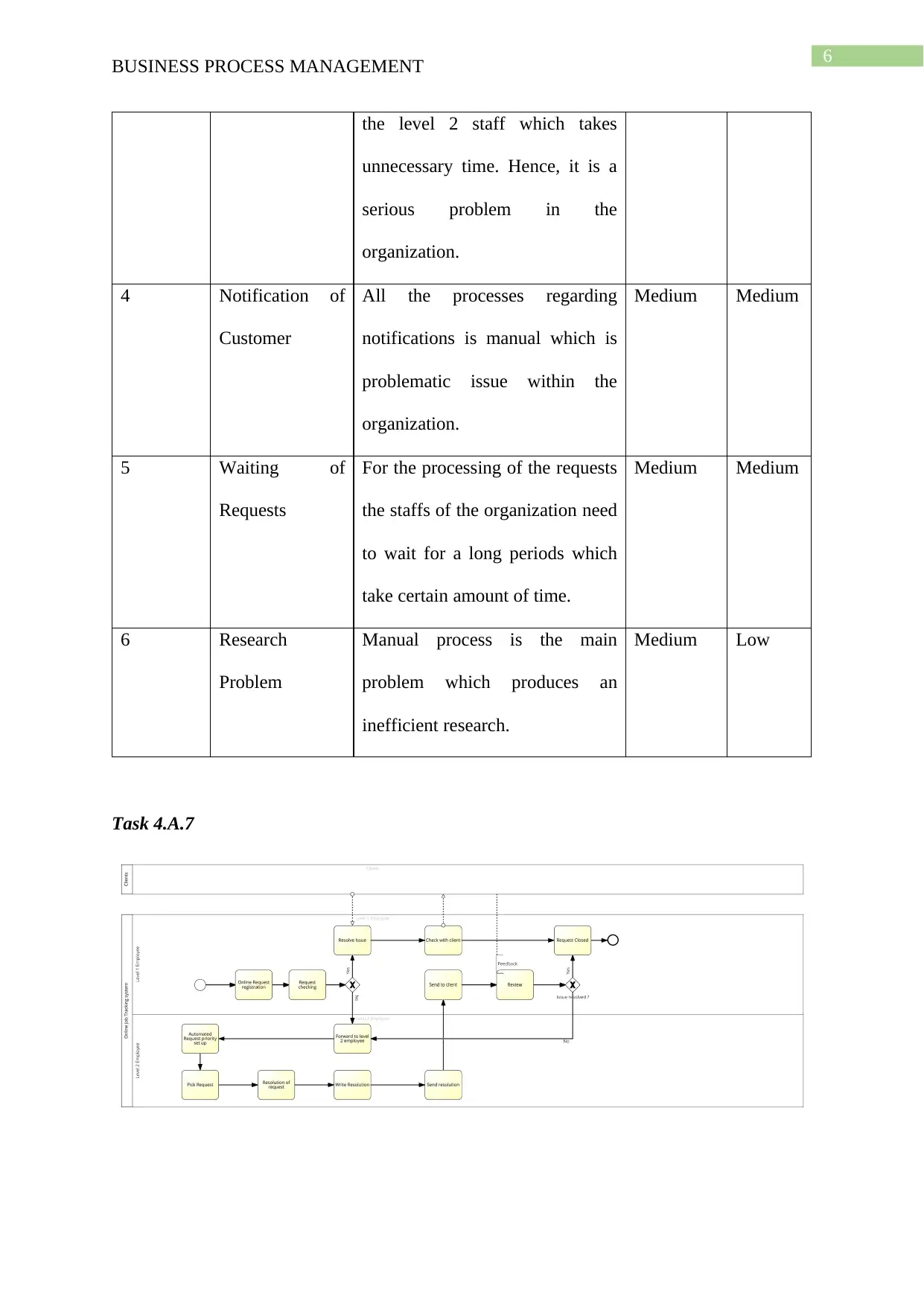
6
BUSINESS PROCESS MANAGEMENT
the level 2 staff which takes
unnecessary time. Hence, it is a
serious problem in the
organization.
4 Notification of
Customer
All the processes regarding
notifications is manual which is
problematic issue within the
organization.
Medium Medium
5 Waiting of
Requests
For the processing of the requests
the staffs of the organization need
to wait for a long periods which
take certain amount of time.
Medium Medium
6 Research
Problem
Manual process is the main
problem which produces an
inefficient research.
Medium Low
Task 4.A.7
BUSINESS PROCESS MANAGEMENT
the level 2 staff which takes
unnecessary time. Hence, it is a
serious problem in the
organization.
4 Notification of
Customer
All the processes regarding
notifications is manual which is
problematic issue within the
organization.
Medium Medium
5 Waiting of
Requests
For the processing of the requests
the staffs of the organization need
to wait for a long periods which
take certain amount of time.
Medium Medium
6 Research
Problem
Manual process is the main
problem which produces an
inefficient research.
Medium Low
Task 4.A.7
Paraphrase This Document
Need a fresh take? Get an instant paraphrase of this document with our AI Paraphraser
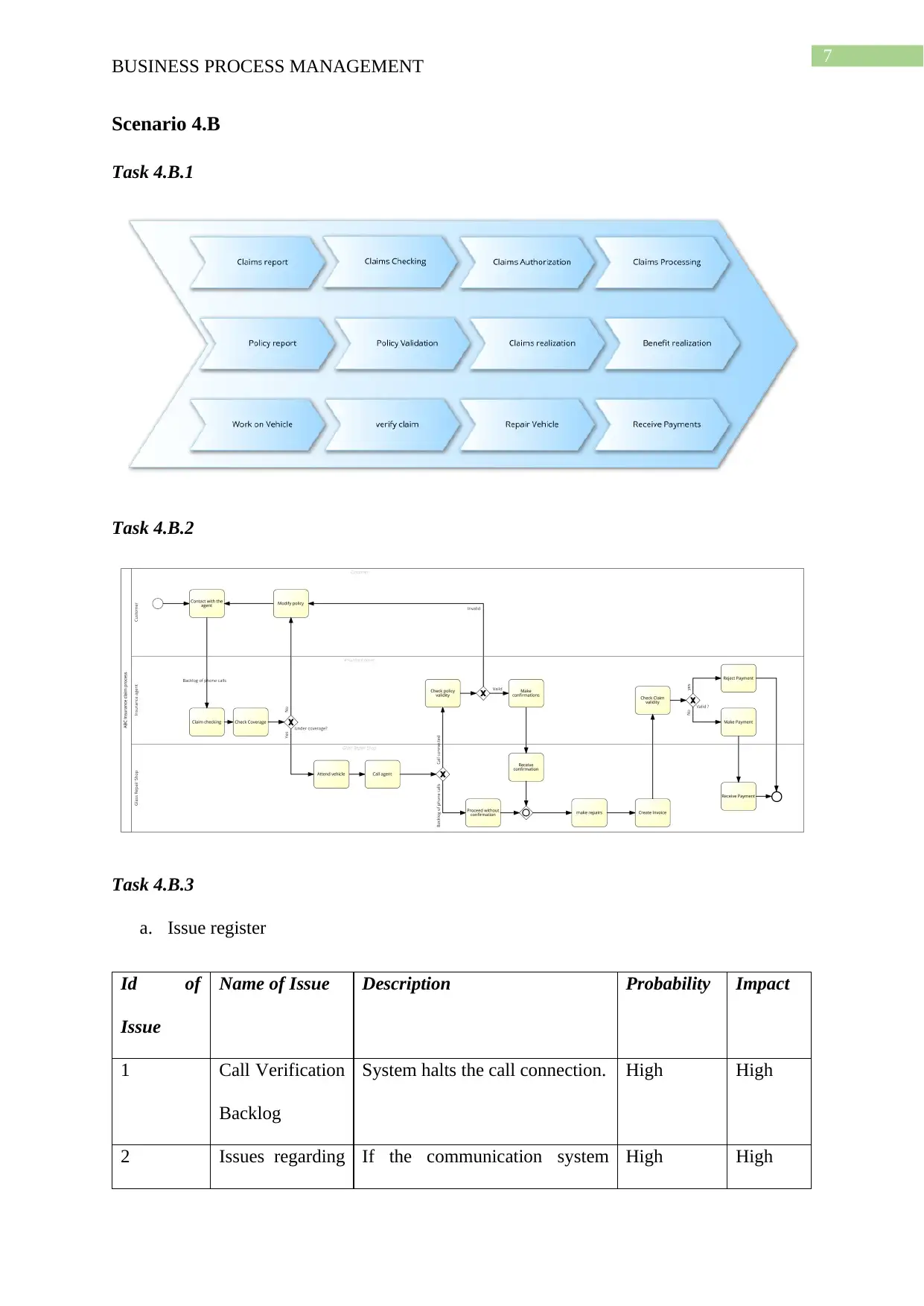
7
BUSINESS PROCESS MANAGEMENT
Scenario 4.B
Task 4.B.1
Task 4.B.2
Task 4.B.3
a. Issue register
Id of
Issue
Name of Issue Description Probability Impact
1 Call Verification
Backlog
System halts the call connection. High High
2 Issues regarding If the communication system High High
BUSINESS PROCESS MANAGEMENT
Scenario 4.B
Task 4.B.1
Task 4.B.2
Task 4.B.3
a. Issue register
Id of
Issue
Name of Issue Description Probability Impact
1 Call Verification
Backlog
System halts the call connection. High High
2 Issues regarding If the communication system High High
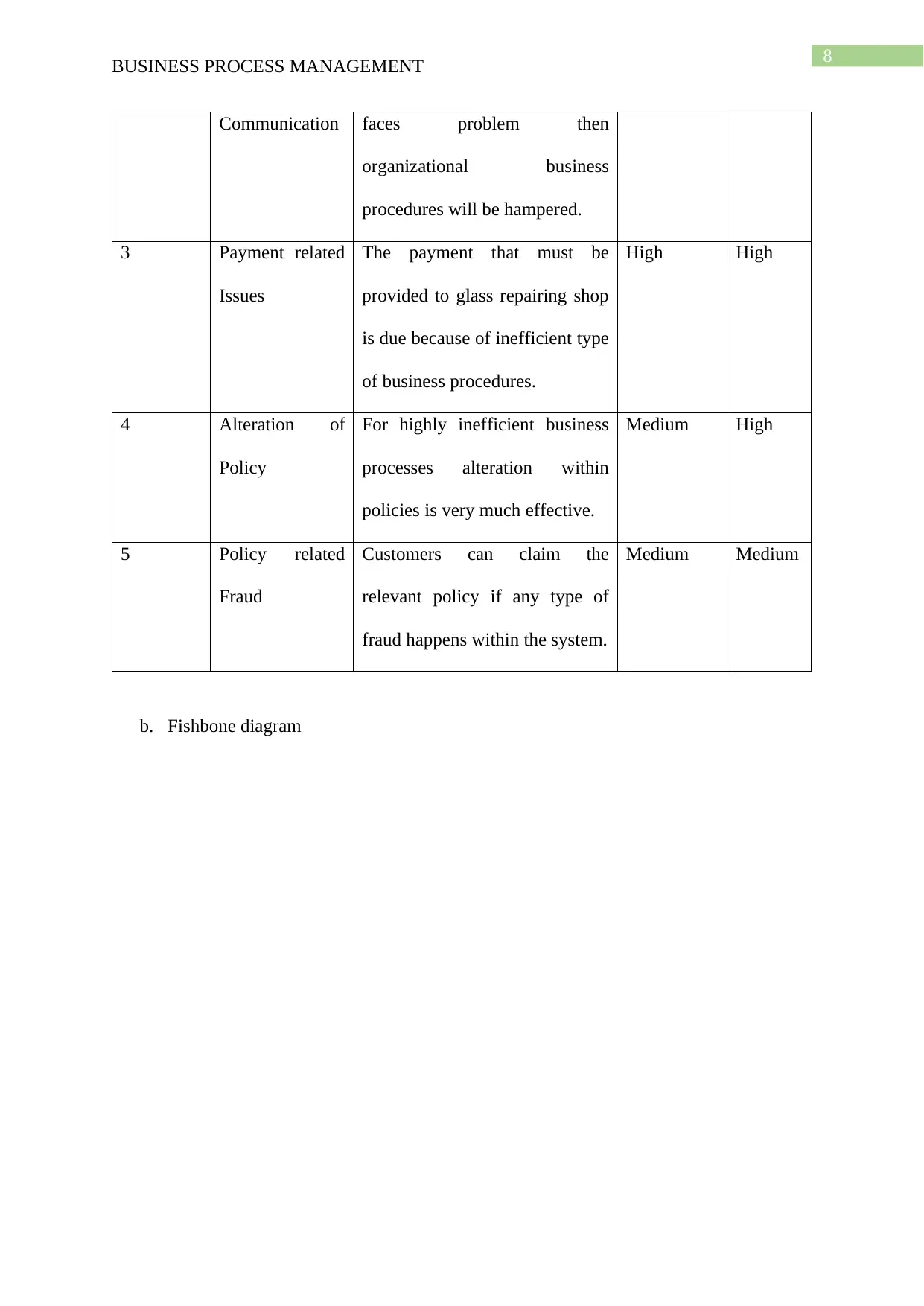
8
BUSINESS PROCESS MANAGEMENT
Communication faces problem then
organizational business
procedures will be hampered.
3 Payment related
Issues
The payment that must be
provided to glass repairing shop
is due because of inefficient type
of business procedures.
High High
4 Alteration of
Policy
For highly inefficient business
processes alteration within
policies is very much effective.
Medium High
5 Policy related
Fraud
Customers can claim the
relevant policy if any type of
fraud happens within the system.
Medium Medium
b. Fishbone diagram
BUSINESS PROCESS MANAGEMENT
Communication faces problem then
organizational business
procedures will be hampered.
3 Payment related
Issues
The payment that must be
provided to glass repairing shop
is due because of inefficient type
of business procedures.
High High
4 Alteration of
Policy
For highly inefficient business
processes alteration within
policies is very much effective.
Medium High
5 Policy related
Fraud
Customers can claim the
relevant policy if any type of
fraud happens within the system.
Medium Medium
b. Fishbone diagram
⊘ This is a preview!⊘
Do you want full access?
Subscribe today to unlock all pages.

Trusted by 1+ million students worldwide
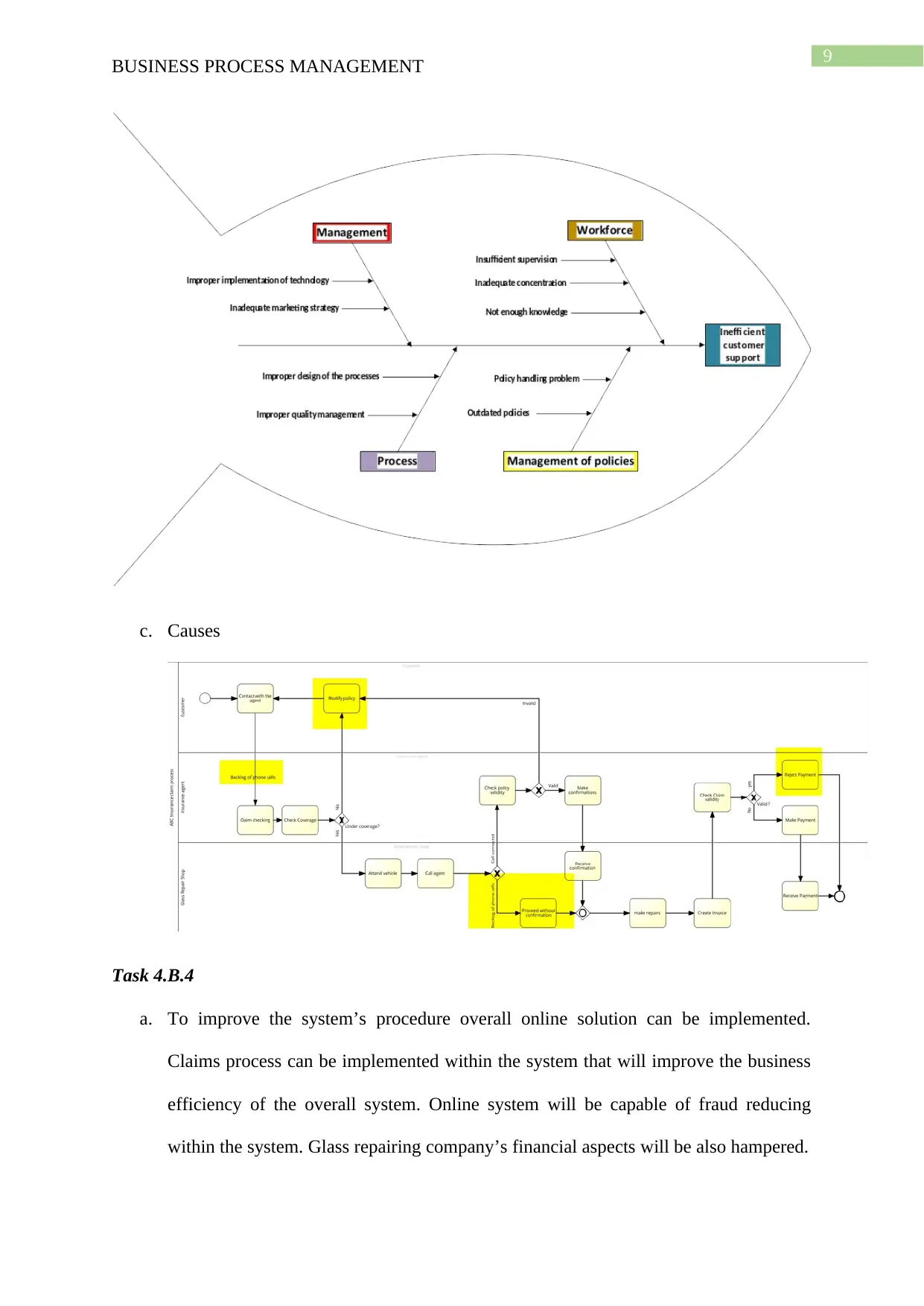
9
BUSINESS PROCESS MANAGEMENT
c. Causes
Task 4.B.4
a. To improve the system’s procedure overall online solution can be implemented.
Claims process can be implemented within the system that will improve the business
efficiency of the overall system. Online system will be capable of fraud reducing
within the system. Glass repairing company’s financial aspects will be also hampered.
BUSINESS PROCESS MANAGEMENT
c. Causes
Task 4.B.4
a. To improve the system’s procedure overall online solution can be implemented.
Claims process can be implemented within the system that will improve the business
efficiency of the overall system. Online system will be capable of fraud reducing
within the system. Glass repairing company’s financial aspects will be also hampered.
Paraphrase This Document
Need a fresh take? Get an instant paraphrase of this document with our AI Paraphraser
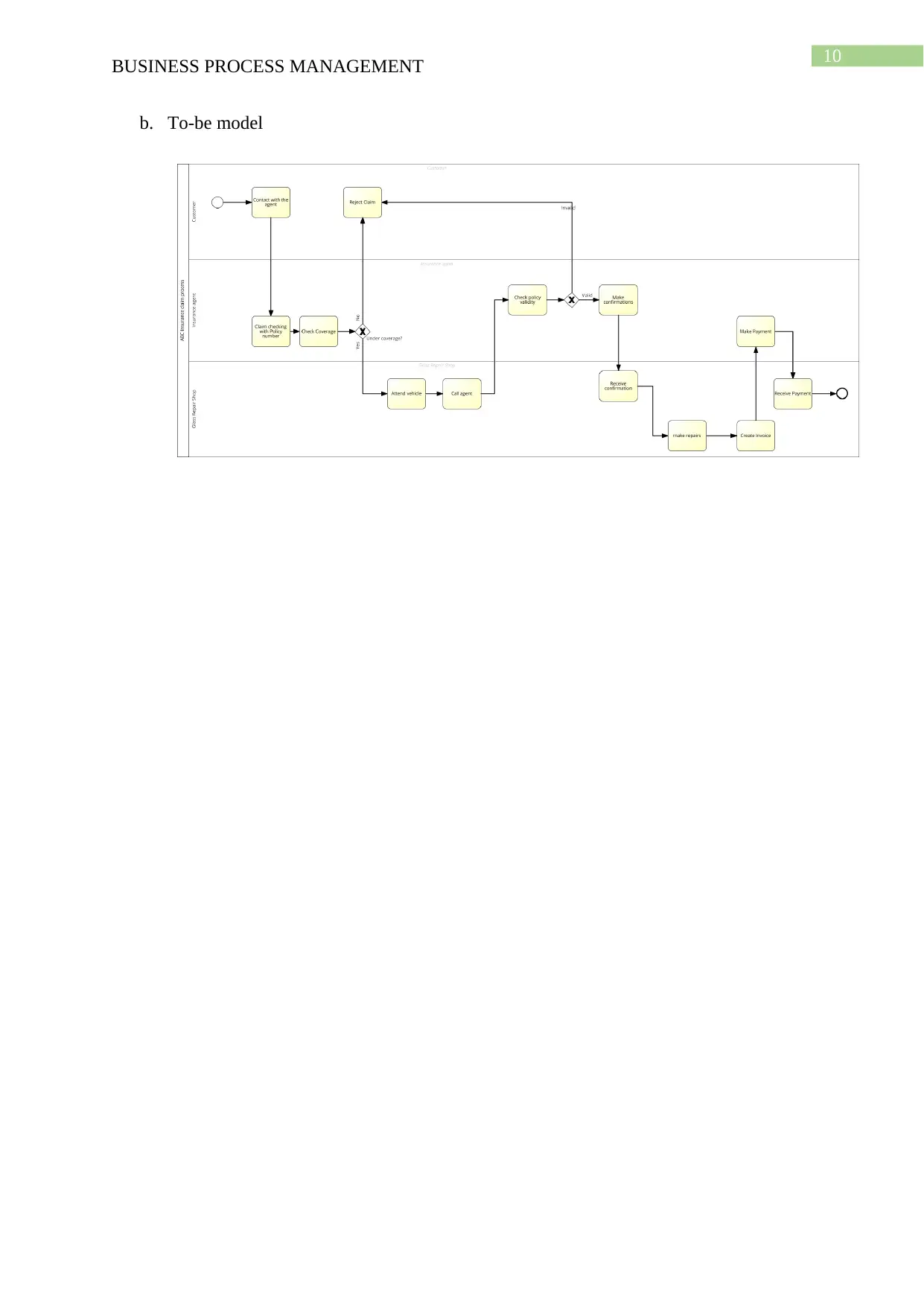
10
BUSINESS PROCESS MANAGEMENT
b. To-be model
BUSINESS PROCESS MANAGEMENT
b. To-be model
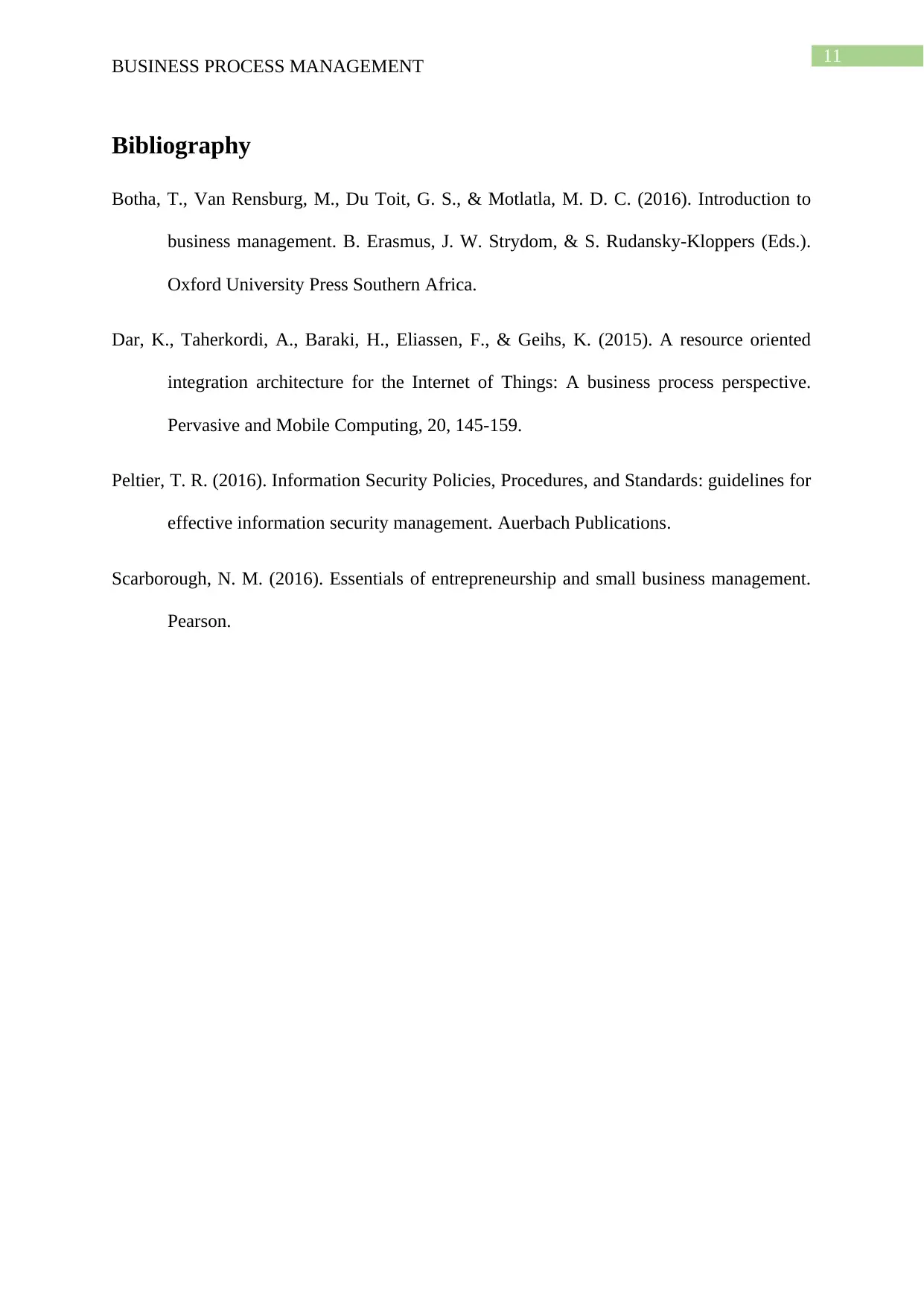
11
BUSINESS PROCESS MANAGEMENT
Bibliography
Botha, T., Van Rensburg, M., Du Toit, G. S., & Motlatla, M. D. C. (2016). Introduction to
business management. B. Erasmus, J. W. Strydom, & S. Rudansky-Kloppers (Eds.).
Oxford University Press Southern Africa.
Dar, K., Taherkordi, A., Baraki, H., Eliassen, F., & Geihs, K. (2015). A resource oriented
integration architecture for the Internet of Things: A business process perspective.
Pervasive and Mobile Computing, 20, 145-159.
Peltier, T. R. (2016). Information Security Policies, Procedures, and Standards: guidelines for
effective information security management. Auerbach Publications.
Scarborough, N. M. (2016). Essentials of entrepreneurship and small business management.
Pearson.
BUSINESS PROCESS MANAGEMENT
Bibliography
Botha, T., Van Rensburg, M., Du Toit, G. S., & Motlatla, M. D. C. (2016). Introduction to
business management. B. Erasmus, J. W. Strydom, & S. Rudansky-Kloppers (Eds.).
Oxford University Press Southern Africa.
Dar, K., Taherkordi, A., Baraki, H., Eliassen, F., & Geihs, K. (2015). A resource oriented
integration architecture for the Internet of Things: A business process perspective.
Pervasive and Mobile Computing, 20, 145-159.
Peltier, T. R. (2016). Information Security Policies, Procedures, and Standards: guidelines for
effective information security management. Auerbach Publications.
Scarborough, N. M. (2016). Essentials of entrepreneurship and small business management.
Pearson.
⊘ This is a preview!⊘
Do you want full access?
Subscribe today to unlock all pages.

Trusted by 1+ million students worldwide
1 out of 12
Related Documents
Your All-in-One AI-Powered Toolkit for Academic Success.
+13062052269
info@desklib.com
Available 24*7 on WhatsApp / Email
![[object Object]](/_next/static/media/star-bottom.7253800d.svg)
Unlock your academic potential
Copyright © 2020–2025 A2Z Services. All Rights Reserved. Developed and managed by ZUCOL.





